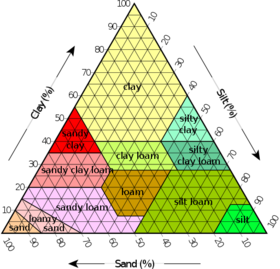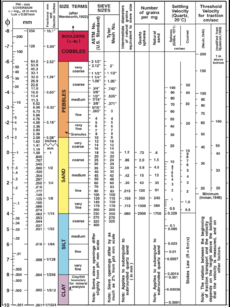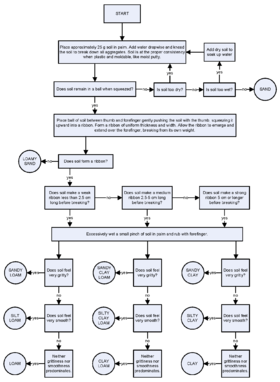Soil Textures
Soil texture is a parameter used in both the field and laboratory as an instrument of classification. The physical texture of the soil is used to determine such classification. This texture can be determined using qualitative methods like texture by feel, and also by using multiple quantitative methods such as the hydrometer method, the pipette method, the POM (particulate organic matter) method, or the rapid method. The hydrometer method is the most widely used of the quantitative methods. Soil texture focuses primarily on particle sizes that are less than 2 mm in diameter. Those that fit this criterion include sand, silt, and clay. Classification systems are typically based on the observed percentages of sand, silt, and clay. The more frequently used class systems are the USDA soil taxonomy and WRB soil classification systems, and both use 12 classes of texture, and also the UK-ADAS system which uses 11 classes [1].
Texture Classifications

The United States has 12 soil texture classifications that are defined by the USDA [1]. These classifications include sand, sandy loam, loam, silt loam, silt, sandy clay loam, clay loam, silty clay loam, sandy clay, silty clay, and clay [2]. The classifications are all determined by the fractions of sand, silt, and clay present for a particular soil sample. They are typically named for the dominating soil particle size (clay, silt, sand) or a combination of the most abundant ones (sandy clay, silty clay). Loam is a mixture of particle sizes composed mostly of sand, silt, and a smaller amount of clay. By weight, its mineral composition is about 40–40–20% concentration of sand-silt-clay, respectively. These proportions can vary, resulting in 5 of the previously mentioned classifications other than loam itself (clay loam, sandy loam, etc..). [ When one wants to determine soil texture, assistance from a soil texture triangle is usually needed [2]. The image to the right is an example of a typical texture triangle [9]. Each side of the triangle represents the percentages of sand, silt, and clay within a given soil sample. The closer you get to one side of the triangle, the percentage of that soil particle size will be greater. The triangle provides aid only if you know what percentages of sand, silt, and clay that you have in your given soil sample (see The Hydrometer method). Once those percentages are found the triangle can be used in a very grid like fashion to determine which of the 12 classifications your sample falls into. To use the triangle, start with one of your particle size percentages, let’s say silt, and locate where that is on its side of the triangle. Then follow the slanted line down to the left until you arrive at your percentage of clay. That point’s location will tell you what soil class you have. Essentially after you choose your starting particle size side, move parallel to your second particle size side to locate your point. For example, if you find that your soil sample is 60 percent silt and 35 percent clay then your soil is classified as silty clay loam. This method can be used in a similar manner starting from any side of the texture triangle. The triangle can also be used inversely to see what percentages of each particle size is generally present for each soil class if one is using the texture by feel method.
Texture is also related to chemical and physical properties of the soil. The distribution and particle sizes have an effect on the soil’s capacity for holding nutrients and water. Soils with finer textures will exhibit a higher water retention capacity, but this will decrease as particle size increases with a coarser soil texture [3].
Particle Sizes

For soil, there are specific particle size ranges that determine what its components are classified as. Be it clay, silt, or sand. Clay particles are amongst the smallest, having diameters of less than 0.002 mm. Clay is structured in a plate-like manner which also allows for its hydroplastic properties induced by the increased surface area due to its small particle size [4]. Following clay are silt particles having diameters between 0.002 mm and 0.05 mm with the USDA classification. Sand has the largest of the particle sizes with diameters ranging from 0.05 mm to 2.00 mm. Sand is divided further due its large diameter range into the categories of very fine sand, fine sand, medium sand, coarse sand, and very coarse sand. The USDA and WRB classifications differ only slightly in the ranges of particle diameter, but both classify clay particles with the same value. The chart to the right provides a more detailed description of the soil particles and their classifications [8].
| Soil particle names | Diameter Ranges (mm)
USDA classification |
Diameter Ranges (mm)
WRB classification |
|---|---|---|
| Clay | less than 0.002 | less than 0.002 |
| Silt | 0.002 - 0.05 | 0.002 - 0.063 |
| Very fine sand | 0.05 - 0.10 | 0.063 - 0.125 |
| Fine sand | 0.10 - 0.25 | 0.125 - 0.20 |
| Medium sand | 0.25 - 0.50 | 0.20 - 0.63 |
| Coarse sand | 0.50 - 1.00 | 0.63 - 1.25 |
| Very coarse sand | 1.00 - 2.00 | 1.25 - 2.00 |
Methods of Determining Soil Texture
Texture by feel Method

This method of determining soil texture is very qualitative. It allows for a quick hands-on approach to assess an estimate as to what soil class you may have. No equipment is required, just some knowledge of particular soil characteristics is needed. These soil characteristics are laid out within the texture by feel flowchart to the right [10]. The flowchart is relatively easy to follow and will help you determine your soil type [5]. Although you will be able to roughly determine what class your soil sample resides in, you won’t directly know what percentages of sand, silt, and clay are present.
To use the texture by feel flowchart, simply start by taking a small portion of your soil sample, wetting it, and trying to form it into a ribbon. This can be done by forming the soil portion into a ball and then pressing it with your fingers until it has a longer flat shape to it. If the ball resists being formed into a ribbon (falling apart) then your soil sample is most likely sand. If the ball doesn’t fall apart but also doesn’t form into a ribbon, then your soil may be a loamy sand. If the soil sample does form a ribbon, then you must determine roughly what length the ribbon is that was able to be formed. Once this is determined, follow the flowchart in the respective path of the ribbon length. Further classification is then found by feeling how gritty or smooth the soil sample feels after you excessively wet it in your palm [1]. The method of texture by feel of course takes practice, but is very useful when lab equipment is not at your disposal or if you are working in the field.
The Hydrometer Method
The hydrometer method, developed in 1927 [7], is a very widely used way to determine soil texture through quantitative means. This method provides percentage estimates of the sand, silt, and clay within a given soil [6]. The major requirement for this method is the use of the chemical compound sodium hexametaphosphate. Sodium hexametaphosphate acts as a dispersing agent to separate aggregates of soil. To carry out this method, start by mixing some of the soil with hexametaphosphate in a test tube. Then place the solution into an orbital shaker overnight or shake the tube with a mixing stone for about 5 minutes, remove the stone, and then place it in a centrifuge for 15 minutes. The solution is then transferred to 1 liter graduated cylinders and then filled with water. The soil is then mixed to help separate the soil particles [6]. The particles separate based on their size and sink. The largest being sand particles with diameters ranging from 0.05 mm to 2.00 mm sink to the bottom first. Following are the medium-sized silt particles with diameters ranging from 0.002 mm to 0.05 mm. Then finally the smallest particles being clay with diameters less than 0.002 mm settle out above the silt layer. A soil hydrometer is then used to take the soil measurements. A soil hydrometer measures the density of a liquid compared to the density of water, or the relative density of the liquid. The hydrometer will need to be placed into a water filled graduated cylinder to allow for proper calibration before measurements can be taken. Record the value of the hydrometer for this “blank” solution. To start the measurements, place the hydrometer into the graduated cylinder with the soil mixture at varying time frames. For sand, place it in for 45 seconds to measure that content. For silt, place it in for 1.5 hours. Then for clay, place it in for 6-24 hours. The number visible on the hydrometer is the value to be recorded [6].
With these values the percentages of sand, silt, and clay can be calculated as follows [6]:
%Silt = (dried soil mass - (sand hydrometer value – blank hydrometer value)/ (dried soil mass) * 100
%Clay = (clay hydrometer value – blank hydrometer value)/ (dried soil mass) * 100
%Sand = 100 – (%Clay + %Silt)
References
[1] Soil Science Division Staff. 2017. Soil survey manual. C. Ditzler, K. Scheffe, and H.C. Monger (eds.). USDA Handbook 18. Government Printing Office, Washington, D.C.
[2] Soil Survey Division Staff (1993). Soil survey manual. United States Department of Agriculture. pp. 63–65. Retrieved 30 August 2014.
[3] Lindbo, Hayes, Adewunmi (2012). Know Soil Know Life: Physical Properties of Soil and Soil Formation. Soil Science Society of America. p. 17. ISBN 9780891189541.
[4] Foth, Henry D. (1990). Fundamentals of Soil Science 8th Edition. Canada: John Wiley & Sons. p. 23. ISBN 0-471-52279-1.
[5] Thien, Steven. "Determining Soil Texture by the "Feel Method"" (PDF). NDHealth.gov.
[6] Bouyoucos, George. 1936. Directions for making mechanical analysis of soils by the hydrometer method. Soil Science. Vol 42 Issue 3: pp 225-230
[7] Bouyoucos G. 1951. A recalibration of the hydrometer method for making mechanical analysis of soils. American Society of Agronomy
[8] Wentworth grain size chart from United States Geological Survey Open-File Report 2006- 1195, "Surficial sediment character of the Louisiana offshore continental shelf region: A GIS Compilation" by Jeffress Williams, Matthew A. Arsenault, Brian J. Buczkowski, Jane A. Reid, James G. Flocks, Mark A. Kulp, Shea Penland, and Chris J. Jenkins
[9] A soil texture diagram redrawn from the USDA webpage. Retrieved 22 October 2011, from https://commons.wikimedia.org/wiki/File:SoilTexture_USDA.png
[10] Natural Resources Conservation Service. (n.d.). Retrieved November 29, 2017, from https://www.nrcs.usda.gov/wps/portal/nrcs/detail/soils/edu/?cid=nrcs142p2_054311